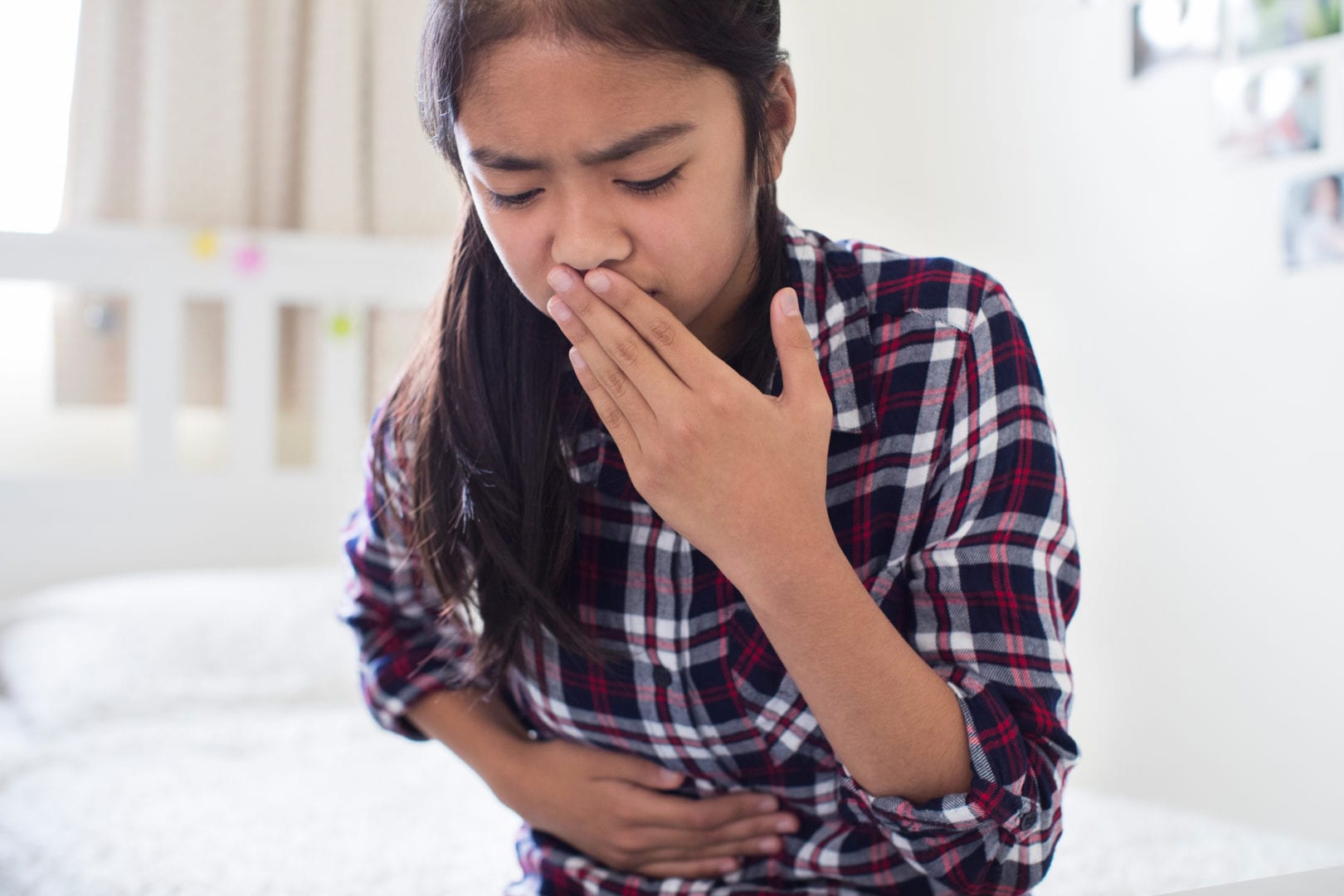More terrifying than the sniffles and more nerve-wracking than an impressively skinned knee, the stomach flu in kids can strike fear in the hearts of the chillest of parents or caregivers. The tummy troubles that accompany it. The loss of appetite. And of course: The barfing! Stomach flu symptoms in kids can be both heartbreaking and, well, hard to stomach. Unfortunately, given kids’ propensity for touching everything (and hand hygiene that’s sometimes less than desirable), the stomach flu is fairly common in little ones — also, despite its colloquial name, it isn’t the flu.
“Viral gastroenteritis, which many refer to as the ‘stomach flu’ is a gastrointestinal infection marked by nausea, vomiting, diarrhea, abdominal pain and sometimes fever,” explains Dr. Rupal Udeshi, director of pediatrics at MedStar Montgomery Medical Center in Olney, Maryland and assistant professor of pediatrics at Georgetown University School of Medicine. “It is not caused by the influenza virus that many people are immunized against. Stomach flu is extremely contagious, with the ability to spread both through person-to-person contact or via contaminated water or food.”
Whether there’s a bout circling at day care or you’re smack dab in the middle of it, here’s expert advice on surviving the stomach flu.
What are the symptoms of stomach flu in kids?
According to Dr. Tina Q. Tan, attending physician, Division of Infectious Diseases at Ann & Robert H. Lurie Children’s Hospital of Chicago, stomach flu symptoms typically appear 24-48 hours after exposure to the virus. Here’s what to look for:
- Fever (usually low grade).
- Watery diarrhea.
- Abdominal cramping.
- Nausea and vomiting.
“With babies and toddlers, look for fever, fussiness, vomiting and diarrhea,” Tan explains. “They may not be able to verbalize nausea or abdominal cramping.”
What treatment or stomach flu home remedies work for kids?
When it comes to vomiting in infants and children, Tan notes that “there’s really nothing that’s recommended unless they’re becoming very dehydrated,” in which case they should see a doctor (more on this in a bit). To make kids more comfortable at home during a bout of gastroenteritis, Tan advises the following:
- Give small amounts of fluids frequently. “This is the best way to keep children hydrated and keep up with fluid losses from the vomiting or diarrhea,” she notes.
- Acetaminophen or ibuprofen. “These can be used to bring down the fever and ease discomfort,” Tan explains. The American Academy of Pediatrics (AAP) recommends parents and caregivers consult their doctor before giving medication to children 3 months or younger.
What foods can a child with a stomach virus eat?
Both Tan and Udeshi recommend bland foods for children who are sick with or recovering from gastroenteritis. “If a child is able to eat, the bland foods of the BRAT diet — bananas, rice, applesauce and toast — are the traditional go-to for children with upset stomachs,” Udeshi says. “But other bland and easily digested foods are OK, as well.”
According to Tan, these are foods children should avoid:
- Dairy products, such as milk, cheese, yogurt and ice cream.
- Foods that are high in fiber.
- Greasy or spicy foods.
“These are harder to digest and more likely to exacerbate stomach upset, vomiting and diarrhea,” Tan says.
How do you hydrate a child with stomach flu?
“In many cases, dehydration can occur with gastroenteritis due to the amount of liquid lost during vomiting or diarrhea, Udeshi says. “So more important than having kids consume solid foods, parents and caregivers should make sure they drink plenty of non-caffeinated liquids to stay hydrated.” Udeshi also recommends hydrating kids slowly when they’re sick with the stomach flu — think sips, not gulps.
For young infants, Tan recommends breast milk or formula to keep them hydrated. “Water or Pedialyte can work for toddlers and younger kids while older children can also drink Gatorade or Powerade, which are electrolyte-replacing fluids.”
When should I take my child to the doctor for stomach flu?
Symptoms of gastroenteritis typically go away on their own after about two days, but Udeshi and Tan recommend contacting a healthcare provider for the following in kids of all ages:
- Vomiting that lasts more than several consecutive hours.
- Severe diarrhea.
- Unusual drowsiness.
- Abdominal pain.
- Appearance of dehydration. (Compare how much they’re drinking to how much they’re urinating.)
The Mayo Clinic also adds the following red flags:
- Blood in stool.
- A fever of 102 F or higher.
Additionally, the Mayo Clinic advises getting medical help for the following symptoms in babies:
- No wet diapers in six hours.
- A sunken soft spot on the top of the head.
- A dry mouth or crying without tears.
“Infants and children with profuse vomiting or diarrhea, who are not able to keep up with their fluid losses should be seen by their primary care physician or in an emergency room where IV fluids can be given and medications such as Zofran can be administered, which helps to treat the nausea,” Tan notes.
How to tell if it’s the stomach flu or COVID?
It’s natural to wonder if every sniff, cough and fever is related to COVID-19 right now, but typically stomach viruses come on fast and furious, according to Udeshi.
“While most children with gastroenteritis have a rapid onset of symptoms and start to feel sick and nauseous for several days, children with COVID-19 may not have any symptoms or may have a fever for a short period of time, along with congestion, cough and loss of taste and smell,” she says. “If you’re concerned about a child’s exposure or risk factors for COVID, consult their doctor and act accordingly by isolating at home.”






